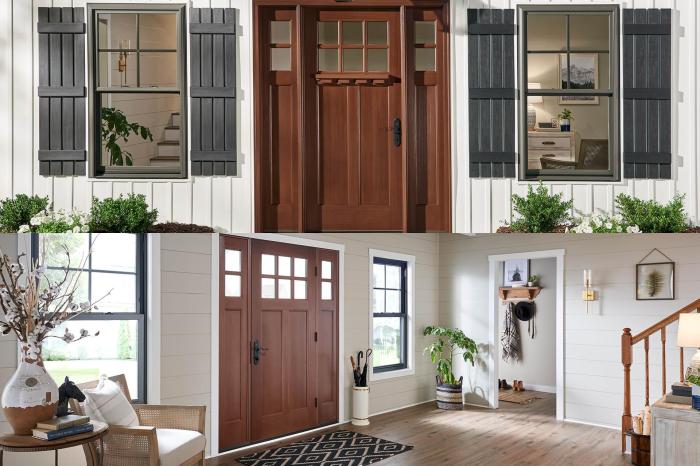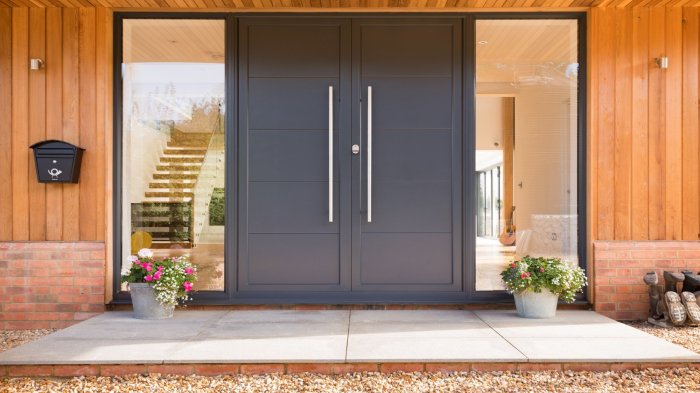Windows and doors play a crucial role in the aesthetics and functionality of any building. From classic designs to modern innovations, the world of windows and doors offers a diverse array of options to suit different architectural styles and preferences.
In this guide, we will delve into the various types, materials, installation processes, and energy efficiency aspects of windows and doors, providing you with valuable insights to make informed decisions for your space.
Types of Windows and Doors
Windows and doors come in a variety of types, each with unique features that cater to different architectural styles and preferences.
Types of Windows:
- Single Hung Windows: These windows have a movable lower sash while the upper sash is fixed.
- Double Hung Windows: Both the upper and lower sashes are movable, allowing for better ventilation.
- Casement Windows: Hinged on one side, these windows open outward like a door, providing excellent ventilation.
- Sliding Windows: These windows slide horizontally, making them easy to operate and great for contemporary designs.
Types of Doors:
- Panel Doors: These doors consist of panels that can be raised or flat, adding a classic look to any home.
- French Doors: Typically made of glass, these doors add elegance and allow natural light to flow into the room.
- Sliding Doors: Perfect for small spaces, sliding doors save space by not swinging open.
- Dutch Doors: These doors are divided horizontally, allowing the top and bottom halves to open independently.
Materials Used in Windows and Doors
Windows and doors are made from a variety of materials, each with its own set of benefits and drawbacks. The choice of material can impact the durability, maintenance requirements, and even the environmental footprint of the windows and doors.
Wood
Wood is a classic choice for windows and doors, known for its natural beauty and insulation properties. However, wood requires regular maintenance to prevent rotting, warping, or insect damage. It can be more susceptible to weather damage compared to other materials.
Vinyl
Vinyl windows and doors are low-maintenance and cost-effective. They are also energy-efficient and durable, resisting rotting, peeling, and fading. However, vinyl may not offer the same aesthetic appeal as wood and can be less customizable in terms of colors and finishes.
Aluminum
Aluminum is a strong and lightweight material used in modern window and door frames. It is resistant to corrosion and requires minimal maintenance. However, aluminum is a good conductor of heat and cold, which can impact energy efficiency.
Fiberglass
Fiberglass windows and doors are highly durable and energy-efficient, providing excellent insulation properties. They are also low-maintenance and resistant to warping, rotting, and swelling. Fiberglass can be more expensive than other materials upfront.
Composite
Composite materials, such as fiberglass-reinforced plastic, combine the benefits of different materials. They are strong, durable, and energy-efficient, offering a good balance between cost and performance. However, composite materials may not have the same aesthetic appeal as natural wood.
Environmental Impact
When considering the environmental impact of windows and doors, materials like wood sourced from sustainably managed forests or recycled aluminum can be more eco-friendly choices. Energy-efficient materials, such as fiberglass and vinyl, can also contribute to reducing energy consumption in buildings.
Installation Process

Installing windows and doors is a crucial part of any construction or renovation project. A proper installation ensures functionality, energy efficiency, and aesthetics. Here we will discuss the general steps involved, tips for preparation, the importance of insulation and sealing, and common challenges faced during the process.
General Steps in Installing Windows and Doors
- Measure the opening carefully to ensure a proper fit for the window or door.
- Prepare the opening by removing any old fixtures, debris, and ensuring it is clean and level.
- Apply insulation around the opening to prevent air leakage and enhance energy efficiency.
- Place the window or door into the opening, ensuring it fits snugly and is level and plumb.
- Secure the window or door in place using appropriate fasteners and sealants.
- Test the operation of the window or door to ensure it opens, closes, and locks properly.
Tips for Preparation and Proper Fit
- Check the dimensions of the window or door and the opening to avoid any misfits.
- Ensure the opening is clean, free of debris, and properly leveled to prevent any issues during installation.
- Use shims to adjust the position of the window or door for a perfect fit.
Importance of Insulation and Sealing
Proper insulation and sealing are crucial during window and door installation to prevent air leaks, moisture intrusion, and energy loss. Insulation helps in maintaining the desired temperature inside the building, while sealing ensures a tight barrier against external elements.
Common Challenges and How to Overcome Them
- Uneven openings: Use shims and adjust the placement to ensure a level and plumb installation.
- Improper sealing: Ensure to apply sealants correctly to prevent air and water infiltration.
- Difficulties in operation: Check for any obstructions and adjust the installation for smooth operation.
Energy Efficiency
Windows and doors play a crucial role in the energy efficiency of a building, impacting factors such as insulation, air leakage, and heat transfer.
U-factor and its Significance
The U-factor measures how well a window or door prevents heat from escaping. A lower U-factor indicates better insulation and higher energy efficiency. For energy-efficient windows and doors, look for a low U-factor rating to reduce heat loss and energy consumption.
Choosing Energy-Efficient Windows and Doors
When selecting windows and doors for different climates, consider factors like insulation, solar heat gain, and air leakage. In colder climates, opt for windows with low U-factor ratings to retain heat, while in warmer climates, focus on minimizing solar heat gain to reduce cooling needs.
Weather-Stripping and Insulation
Weather-stripping and insulation are essential components in improving the energy efficiency of windows and doors. Properly sealed windows and doors prevent air leakage, reducing energy waste and improving overall insulation. Regular maintenance and upgrades to weather-stripping and insulation can enhance energy efficiency and comfort within a building.
Closing Summary

As we conclude our exploration of windows and doors, we have uncovered the essential factors to consider when choosing the right options for your home or building. From understanding the different types and materials to grasping the importance of energy efficiency, this guide equips you with the knowledge to enhance both the functionality and visual appeal of your space.
Whether you are embarking on a renovation project or constructing a new property, the insights shared here will guide you towards making well-informed decisions regarding windows and doors.
FAQ Corner
What are the benefits of choosing energy-efficient windows and doors?
Energy-efficient windows and doors help reduce energy consumption, lower utility bills, and create a more comfortable indoor environment by minimizing heat transfer.
How do different materials used in windows and doors impact their durability?
Materials like vinyl and fiberglass are known for their durability and low maintenance requirements, while wood offers a traditional aesthetic but may require more upkeep to prevent decay.
What role does proper insulation play during the installation of windows and doors?
Proper insulation ensures that there are no air leaks around the windows and doors, which helps maintain a consistent indoor temperature and enhances energy efficiency.
What are some common challenges faced during the installation of windows and doors?
Common challenges include ensuring a proper fit, dealing with structural obstacles, and addressing issues related to moisture control to prevent damage over time.